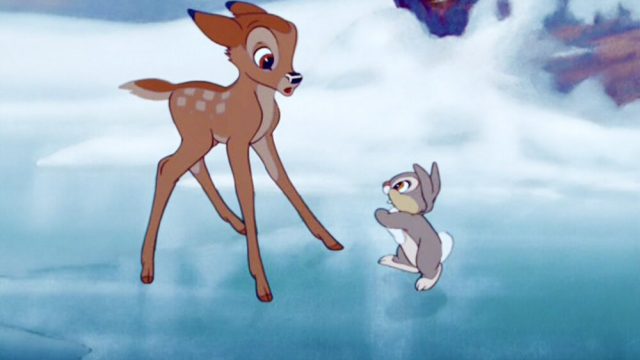It was probably the 1947 rerelease. My aunt would’ve been seven at the time, but that seems more likely than that it was the 1942 original, when she was two. During That Moment, my aunt burst out, “I don’t want Bambi’s mother to die!” This is probably one of the most common laments of her generation, frankly. Anyway, according to my grandmother, the guy behind her sniffed, “Damn kid!”
One day, a young deer is born in the forest. The other animals refer to him as “the young prince,” for he is the son of the Great Prince of the Forest, the oldest of the stags. His mother, who is never named, tells them that her son will be called Bambi. He meets a young rabbit named Thumper, who teaches him to talk; in one of the moments of comedy added for the movie, he then calls a young skunk Flower. Bambi grows and learns, and what he learns is that the biggest threat to him in the forest is Man. Who is never seen, which is the only reason he isn’t killed in the forest fire scene.
To be fair, that’s because there don’t appear to be any other predators in the forest. Friend Owl, to be sure, but no wolves, foxes, and so forth. The only one who hunts the deer is Man. And we never acknowledge that Friend Owl would likely eat Thumper in the real world. Skunks are omnivores, too, and it appears that at least one skunk has been observed going into a rabbit burrow. So, you know, there’s all that. But it is true that the most common predator in a lot of forests, both in Europe and in North America, is human hunters.
This has led to some very weird statements about this movie, one of the first explicitly environmentalist films ever made. Ted Nugent says we shouldn’t use it as an anti-hunting movie, because we know that the hunters used every part of Bambi’s mother. Where, exactly, he gets this idea, I couldn’t even begin to tell you. The IMDb trivia points out that it’s illegal to kill a doe with a fawn, as if that necessarily means it doesn’t happen; the selfsame trivia section also mentions a poacher who was sentenced to, among other things, watch this movie once a month for a year.
At that, it wasn’t meant to be explicitly anti-hunting; Walt was fairly firm on that. Hell, Felix Salten, the original author, was himself a hunter. (In point of fact, it was supposed to be some sort of allegory about the dangers faced by Jews, it seems, though probably I’d have to read it to understand that. Certainly Salten was himself Jewish, and his works were banned by the Nazis, including this one.) A strong argument can be made that it’s a practical effect of personifying a prey species, and you can’t make a version of the story that isn’t anti-hunting whatever your intention, but that wasn’t the point of the movie or the book.
It really is a beautiful movie, though. Its backgrounds were designed by Tyrus Wong, a Disney animator and long-time Hollywood production designer; they’re intentionally made not to distract from the action, so the focus is on the animals, not the trees. The animators definitely spent time observing real-life animals; weirdly, it’s the dogs—surely the animal they were most familiar with—who look the least convincing and realistic. This is one of Disney’s most realistic films, which makes it even more frustrating that it’s apparently intended to get the “live-action” treatment at some point.
There are a lot of differences between the movie and the original book, but the first and most obvious without having read the book is that the setting has been changed. Bambi is a white-tailed deer, not a roe deer, as roe deer are not native to the Americas. Walt apparently initially wanted a mule deer but was talked into the change. Sure, rabbits are everywhere, but skunks are native to the Americas as well. The very word comes from the Algonquian and Iroquoian names for the animal. The original book is also very much Not For Children, even beyond the whole “trauma of a generation” thing, being considerably more violent and more detailed about mating. Also, Bambi and Faline are cousins.
The movie’s cultural impact is interesting, if you think about it; Bambi was a girl’s name first, stemming from at least a 1913 book—it’s from “bambino,” the Italian for “child”—but the most famous cultural Bambi is male. There’s also the whole hunting thing. The idea of Man as a dangerous force to be wary of is so solidly put in place by the film that the Disney animators used “Man is in the forest” as code for “Walt’s coming.”
My Disney+ membership is up this month; help me keep these articles coming by supporting my Patreon or Ko-fi!

